Abstract
Nasopharyngeal ventilation (NPV) is a common technique used to support breathing, particularly when a patient’s respiration is inadequate, such as under sedation. It involves delivering oxygen through an endotracheal tube positioned above the glottis. Accurate tidal volume measurement is crucial for anesthesiologists, with the gold standard being a pneumotachograph. However, due to leakage from the mouth or mask, this method has limitations when applied to NPV. This study introduces a computational model that calculates respiratory flow in real time by accounting for leak flow. Results show that tidal volume measurements using this method are comparable to the gold standard, assuming the model’s assumptions hold true.
1. Introduction
In clinical practice, there are many situations that require ventilatory support by non-invasive ventilation (NIV), i.e., ventilation that does not demand endotracheal intubation of the patient. NIV can and should be used in all patients who are able to breathe spontaneously during most of the period of ventilatory support, but at a level that is insufficient to meet the physiologic demands [,].
NIV is delivered through various interfaces that connect the ventilator system to the patient’s airway. The most commonly used NIV interfaces in clinical practice are facial or nasal masks; nasal cannulae; endotracheal tubes inserted into the oropharyngeal cavity, i.e., nasopharyngeal tubes (NPTs); and helmets []. We refer to nasopharyngeal ventilation (NPV) when an NPT is used.
NPTs connected to a ventilator bag allow anesthesiologists to either assist spontaneous breathing or provide mandatory ventilation when the patient’s breathing is too shallow, as occurs under procedural sedation []. In addition, when combined with a specific algorithm, the NPT allows pharyngeal pressure calculation without the need to insert the additional cannula required for direct in situ pressure measurement. Such an algorithm, developed from a fluid dynamic model similar to the one described in the Materials and Methods (Section 2.3), has shown its feasibility in the field of pediatric anesthesia [].
Unlike mechanical ventilation, where the leak flow at the interface occurs only when the cuff at the distal end of the endotracheal tube is not properly sealed to the inner wall of the trachea or is intentionally left deflated [,], during NIV, leak flow occurs systematically at all types of interfaces and cannot be avoided [,,]. In addition, the magnitude of this leak flow cannot be predicted or estimated during treatment, so the output signal from the monitoring system’s sensors is not useful for accurate measurements of the respiratory flow waveform over time [,,]. Specifically, because the flow sensor is placed upstream of the leak that occurs at the interface, its reading output overestimates or underestimates the instantaneous value of the true respiratory flow during inspiration and expiration, respectively. As a result, erroneous readings, if not corrected or compensated for, lead to unacceptable errors in the respiratory flow waveform over time and, consequently, in both the inspiratory and expiratory tidal volumes.
This error is not only a diagnostic problem, but also a therapeutic one, since the efficacy and safety of the NPV are strongly based on the correct determination of diagnostic parameters []. For these reasons, in all NIV modalities and for all types of interfaces and patients, it is essential to develop algorithms that allow the estimation of the leak flow waveform that occurs at the interface during breathing to be used to correct the measured respiratory flow waveform and ultimately to obtain the true respiratory flow waveform over time. Different types of algorithm have been proposed in this context, but none of them is compatible with NPT ventilation supported by the free-flow oxygen delivery device (FFODD) [,,]. This is due to the impossibility of confining and therefore monitoring the patient’s upper airway from a fluid point of view, even partially, during clinical procedures associated with NPV. Among these algorithms, differential spirometry stands out, which is not feasible in NPV because it requires the use of a face mask equipped with a flow sensor [,,,].
The objective of this study is to delineate a novel computational methodology for respiratory flow monitoring in the clinical context of procedural sedation necessitating NPV, either in the spontaneous or mandatory mode. This methodology, facilitated by a designated algorithm, enables the calculation and real-time monitoring of the waveform over time of leak flow and, consequently, those of respiratory flow and tidal volume. The algorithm’s reliability was substantiated in an in vitro study that emulated the previously reported clinical scenario.
2. Materials and Methods
2.1. Description of the Ventilatory System (FFODD) Used with the NPT for NPV
FFODD is used to apply either continuous positive airway pressure (CPAP) ventilation in the spontaneous mode through the NPT interface or mandatory ventilation []. Figure 1 shows a schematic representation of FFODD combined with NPT.
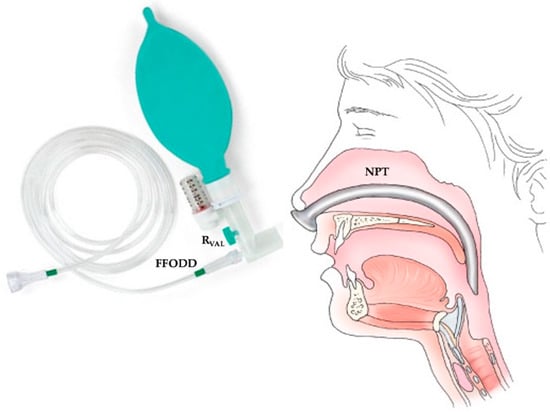
Figure 1.
The FFODD is connected to the NPT, which is inserted through a nostril for NPV. The FFODD system has four pipes that are connected at the branch point. The first pipe is the inlet pipe. It receives the flow from the generator. The second pipe ends with a variable resistance valve (RVAL). The third pipe is the tube that fills the balloon. The fourth pipe connects to the NPT. The flow delivered by the generator is set based on the patient’s needs.
The CPAP level depends on RVAL, flow rate, and leak flow. Spontaneous breathing causes the airway pressure to oscillate around the CPAP value, with inferior and superior pressures during inspiration and expiration. With mandatory delivery, the airway pressure increases above the CPAP level during inflation and decreases to the CPAP level during expiration. Figure 2 shows the typical airway pressure waveform over time, relative to spontaneous breathing and mandatory delivery.
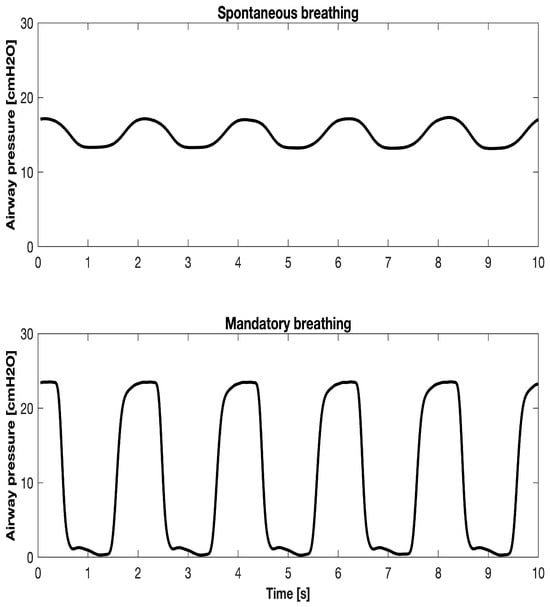
Figure 2.
A typical airway pressure waveform over time during NPV. In the upper panel, the airway pressure waveform of spontaneous ventilation under CPAP is shown, whereas the lower panel shows mandatory ventilation.
2.2. Clinical Context and Experimental Setup Used to Measure and Calculate Leak Flow Waveform
The clinical context involves the simulation of a patient who has been sedated for a gastroscopy and is receiving NPV through an NPT. The patient’s breathing is simulated as either spontaneous or passive (Figure 2).
The corresponding experimental setup included the following units: FFODD, the NPT, the artificial pharynx, the leak channel from the pharynx, and the lung simulator (Figure 3). Using three pneumotacographs (PNTs) and five differential pressure transducers (DPTs), five measuring points monitored the quantities of interest (Figure 3). NPT flow () was measured by the PNT_A combined with the DPT_A, the leak flow () by the PNT_B combined with the DPT_B, the NPT pressure (PNPT) by the DPT_D connected to the side aperture of the NPT pressure connector (NPT_PC), the respiratory flow () by the PNT_C combined with the DPT_C, and the pharyngeal pressure (PPH) by the DPT_E. The DPT_A, DPT_B, and DPT_C are the SensorTechnics (SensorTechnics, Inc., Mansfield, CA, USA) 144LU01D-PCB transducers (full scale 2.54 cmH2O), whereas DPT_D and DPT_E are the SensorTechnics (SensorTechnics, Inc., Mansfield, CA, USA) 144LU10D-PCB transducers (full scale 25.4 cmH2O). The PNT_A, PNT_B, and PNT_C are the PNT series 3700 not heated (flow scale 160 L/min), Hans Rudolph, Shawnee, KS, USA.
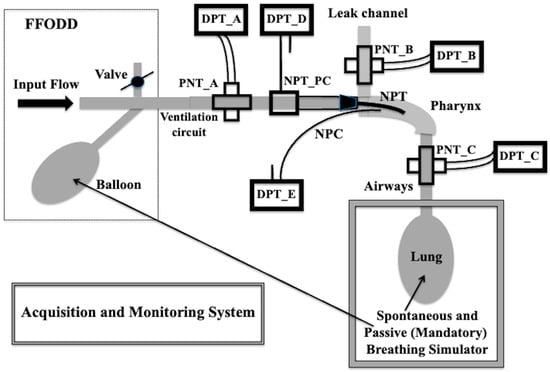
Figure 3.
The experimental setup, including free-flow oxygen delivery device (FFODD), ventilation circuit, nasopharyngeal tube (NPT), nasopharyngeal pressure catheter (NPC), and leak channel, is used for the characterization of the relationship between pharyngeal pressure and leak flow and to calculate its fluidodynamic coefficients. When the lung simulator is included, the patient’s spontaneous or mandatory breathing is simulated so that leak flow, respiratory flow, and tidal volume can be calculated.
As NPTs, we used the 3.0, 4.0, and 5.0 mm internal diameter (ID) endotracheal tubes for children (Rusch, Teleflex Medical, Ireland) and the 7.0, 8.0, and 9.0 mm ID tubes for adults, all bent and kept folded to simulate the real curvature when inserted into the nasopharyngeal cavity. The Acquisition and Monitoring System used is the PicoScope 4824 equipped with its proprietary PicoScope 7 software (Pico Technology, Cambridgeshire, UK). The functional features of sensors and transducers and of the PicoScope 4824 are reported elsewhere []. An ASL 5000 Breathing Simulator (IngMar Medical, Pittsburgh, PA, USA) was used to simulate the spontaneous breathing or the ventilatory mandatory breaths. All the measurements were carried out using one of the most widely employed respiratory gas compositions in clinical practice with NPT ventilation, such as 100% oxygen and sevoflurane in oxygen at 2% concentration (2%Sevo/O2) (Sevorane, AbbVie Inc., North Chicago, IL, USA).
2.3. Physical Model of the Experimental Setup
We adopted the equivalence between fluidic and electric quantities. The equivalent electrical network of the physical model employed to represent the experimental setup (Figure 3) is reported in Figure 4.

Figure 4.
The equivalent electrical network of the physical model. The three pressure points (electric potential difference) relative to PNPT, PPH, and Patm are in bold. The three airflows (electric current) crossing the three branches (, , ) and the fluidodynamic resistance (electric resistance) of NPT (RNPT) and leak channel (RLEAK) are also shown.
Depending on the time point considered during spontaneous or mandatory breathing, the airflow (electric current) on all the branches of Figure 4 can be directed in both directions. The direction of the arrows shown in Figure 4 indicates the direction we arbitrarily chose as positive for the airflow on each branch: from the FFODD to the PPH node for , from the PPH node to the environment for , and from PPH node to the patient’s respiratory system for . In particular, with this setting, the inspiratory (into the patient) and expiratory (out of the patient) flows are positive and negative, respectively. Assuming the inflow into the node is positive and the outflow from the node is negative, applying the equivalent Kirchoff’s first or current law (also known as the continuity law) to the PPH node results in the following equation:
The pressure difference (ΔP) that occurs across two sections of any pipe when a flow () of a real fluid passes through it generally consists of the following four components:
- (1)
- Cinetic or Bernoulli component (ΔPK), which would exist if the fluid were ideal, since it only depends on the geometry;
- (2)
- Viscous or resistive component (ΔPR);
- (3)
- Elastic or capacitive component (ΔPC);
- (4)
- Inertial component (ΔPI).
In NPV, a steady, adjustable flow is set along the NPT, which oscillates around the equilibrium value when the patient breathes spontaneously or when he/she is passively ventilated during apnea. The frequency of the oscillations (respiratory frequency) is always below 1–2 Hz (corresponding to 60–120 respiratory cycles per minute) and its amplitude is almost always lower than the set steady flow, so that the gas crossing the NPT almost never reverses its flow direction and almost never becomes negative, also due to the presence of a constant flow leak downstream of the NPT. For these reasons ΔPI can be neglected. Moreover, the maximum value of PNPT, and therefore of PPH, is limited, so that even ΔPC can be neglected, since the fluid can be considered incompressible (constant density), and the walls of the pipe are perfectly rigid. Finally, considering that the geometry of both the pipes involved (NPT and leak channel) and in particular the cross section sizes of the point where PNPT (connector at the proximal end of NPT, NPT_PC) is measured do not change during the assisted spontaneous breathing, ΔPK, which is not dependent on the value and type of flow (laminar, intermediate, or turbulent), can also be considered negligible because it does not affect neither the measurement of PPH by an NPC nor its calculation.
For all the aforementioned reasons, ΔPR was the only component of ΔP we considered across both RNPT and RLEAK, the airflow fluidodynamic resistances appearing in Figure 4. Assuming that both laminar and turbolent regimes are present and that the ratio between ΔPR and is equal to the fluid dynamics viscous resistance (R) (), then R equals the sum of its laminar and turbolent components, which are non-dependent and linearly dependent on the , as it results from the following expression:
where kL and kT are the laminar and turbolent coefficients related to R.
Considering Equation (2), RNPT and RLEAK assume the following expressions:
where kL_NPT and kT_NPT are the laminar and turbolent coefficients related to RNPT, while kL_LEAK and kT_LEAK are the corresponding coefficients related to RLEAK.
The application of the equivalent Kirchoff’s second or voltage law across RNPT and RLEAK yields the following equations:
As Patm is assumed to be zero, Equation (6) yields the following equation:
Substituting RLEAK from Equation (4) into Equation (7) gives PPH as follows:
2.4. Calculation During Spontaneous or Mandatory Breathing
In order to calculate (see Equation (8)), it is first necessary to measure PPH. This can be accomplished by placing a pressure catheter within the pharynx (NPC, Figure 3). Once the PPH value has been established, the coefficients kL_LEAK and kT_LEAK must be calculated in order to extrapolate .
2.4.1. Method for kL_LEAK and kT_LEAK Calculation
The coefficients kL_LEAK and kT_LEAK are derived from Equation (8), which contains three unknown parameters: the coefficients kL_LEAK and kT_LEAK and the variable . To overcome this challenge, a solution has been formulated as follows: if the patient is apneic, coincides at any time with , which can be measured by PNT_A (Figure 3). This condition can be achieved in vivo because the NPT is inserted after a small amount of sedative has been administered, causing the patient to become sedated and transitorily apneic, so that the gas flowing along the NPT () exits the pharynx and coincides with the leak flow (). Since during apnea is known, the two coefficients kL_LEAK and kT_LEAK can be easily calculated. More specifically, the method starts with building the relationship between the flow rate across the leak channel ()—increased from zero to 20 L/min (0.5 L/min increments) for children and from zero to 50 L/min (0.5 L/min increments) for adults—and the relative increase in PPH. This process is conducted in a stepwise manner. Both PPH and data are plotted one against the other (Figure 5a), yielding a set of points which are interpolated by means of the Rohrer equation () [] applied to the leak channel (Equation (8)). The following step consists in substituting ΔP in the Rohrer equation with PPH, and with , yielding Equation (8). The interpolation with a second-order polynomial allows for the determination of both the coefficients kL_LEAK and kT_LEAK appearing in Equation (8).

Figure 5.
Rohrer’s equation (see Equation (8)) for the leak channel characterization PPH vs. (a) and vs. PPH (b). It is important to note that switching and PPH in the Cartesian axes (b) is useful in the calculation of the from the PPH (see Equation (10)).
2.4.2. Calculation During Spontaneous or Mandatory Breathing Once kL_LEAK and kT_LEAK Coefficients Have Been Calculated During the Apnea
Once kL_LEAK and kT_LEAK have been calculated from the relationship between PPH and at the apnea time, PPH can be measured at any time during breathing and can be calculated accordingly using Equation (8), duly rewritten:
can be extrapolated from the solution of Equation (9):
From Equation (10), it is possible to obtain at any instant of time during spontaneous or mandatory breathing.
2.4.3. , , and Tidal Volume (VTID) Calculation During Spontaneous Breathing
Before a breath starts, there is a respiratory pause (i.e., apnea time), during which and assume their equilibrium values (, ), which coincide (). Because corresponds to the bias flow, we know exactly where the point is on the Cartesian diagram by crossing the bias flow line () with the corresponding PPH line (, QSCF, Figure 6). When the patient starts breathing, the PPH decreases during inspiration and increases during expiration. The same pattern of increase and decrease should be seen with . However, the segment shown in Figure 6 appears almost horizontal, i.e., characterized by a very small amplitude of oscillation around during each breath. This is because in most cases of NPT applications with FFODD in spontaneously breathing patients, RNPT is considerably greater than RLEAK. Consequently, with the patient’s respiratory system being like an ideal flow generator, the oscillation amplitude of occurring during the breathing is almost completely supplied by the oscillation amplitude of . Furthermore, the features of this ideal flow generator do not depend on the capacitive (elastic) components of the patient’s respiratory system in such a way that all the pressures and flows appearing in Figure 4 (and therefore and PPH also) are in phase with each other. This causes the typical hysteresis loop associated with an entire spontaneous breath to be reduced to a segment, also hiding the effect of non-linear RNPT and RLEAK.
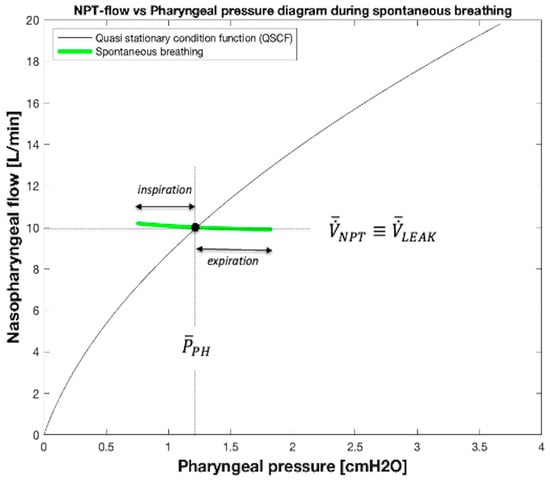
Figure 6.
vs. PPH diagram during spontaneous breathing. The continuous line curve in this figure represents Equation (10) (Figure 5b, QSCF). The green segment is formed by the couple of pharyngeal pressure (PPH) and nasopharyngeal flow () values measured during spontaneous breathing.
To summarize, the oscillation amplitudes of the point that represents the current position in the vs. PPH diagram during inspiration and expiration, i.e., the length of the inspiratory and expiratory portions of the segment shown in Figure 6, both depend mainly on the patient inspiratory effort and expiratory release, whereas the slope of the segment depends on the ratio between the values of RNPT and RLEAK, decreasing as the ratio decreases.
From a graphic point of view (Figure 7), the current value of obtained from Equation (10) can be highlighted in the vs. PPH diagram as the value of corresponding to the intersection between the vertical projection passing through the current monitored value of PPH and the − PPH relationship during apnea (Equation (10), shown in Figure 5b, Figure 6, and Figure 7, QSCF). By way of example, Figure 7 shows the minimum () and maximum () values calculated at mid-inspiration and mid-expiration times, respectively, when PPH assumes its minimum (PPH_mi) and maximum (PPH_me) values, respectively. Furthermore, in Figure 7 the values assumed by at mid-inspiration () and mid-expiration () times, respectively, are also highlighted.
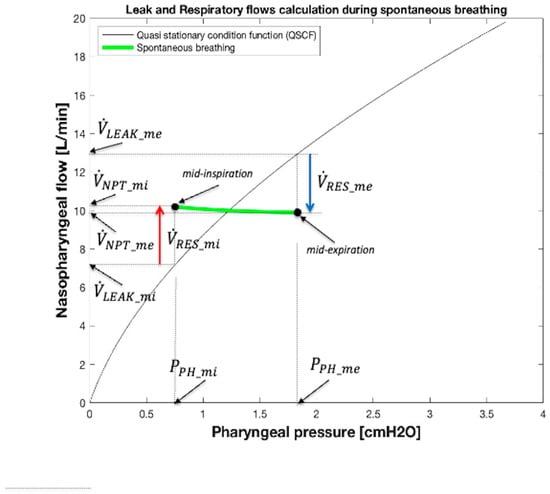
Figure 7.
Graphical method to calculate and at mid-inspiration and mid-expiration times during spontaneous breathing. Starting from the point associated with mid-inspiration on the green segment, a vertical line is drawn to the x-axis until it intersects the QSCF (Equation (10), Figure 5b). From this point, a horizontal line is projected on the y-axis. The point of intersection represents at mid-inspiration. is calculated from Equation (1) as the difference between and (red arrow). The blue arrow represents at mid-expiration.
Finally, during breathing, the current value of associated with the correspondent value of measured PPH can be computed considering Equation (1), i.e., as the difference between the current monitored value of and the synchronized value of obtained by Equation (10). As an example, the lengths of the two vertical arrows and reported in Figure 7 correspond to the maximum (, positive, red arrow) and minimum (, negative, blu arrow) values of occuring at mid-inspiration and at mid-expiration times, respectively. The values of during a whole spontaneous breath, calculated in this way, are shown in Figure 8, where each amplitude of red and blue arrows equals the value assumed by inspiratory () and expiratory () flows, respectively.
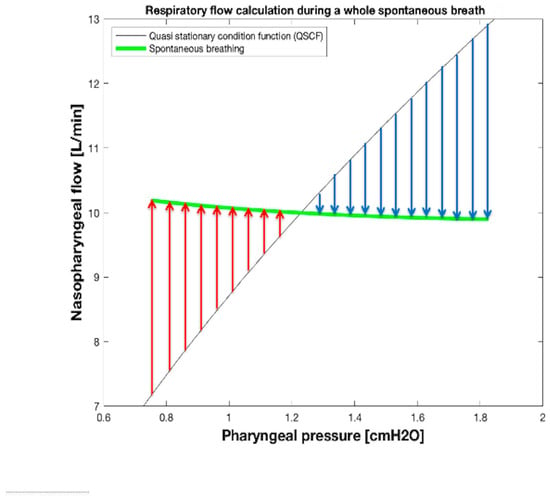
Figure 8.
Graphical method to calculate at any time during spontaneous breathing. The length of each red or blue arrow indicates the inspiratory flow () and expiratory flow () value at that point on the green segment.
From what has been described so far in this section, it results that the and waveforms over time during spontaneous breathing can be computed and monitored real time by inserting into both Equations (1) and (10) the synchronized samples of the PPH and waveforms over time available from monitoring system. Figure 9 shows the , , and waveforms over time during spontaneous breathing obtained with the experimental setup reproducing the clinical scenario used for pediatric applications (Figure 7 and Figure 8). Finally, tidal volume (VTID) was calculated as integral over inspiratory time.
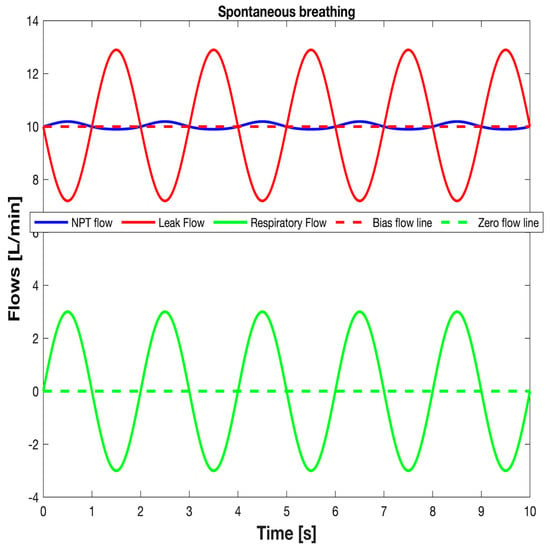
Figure 9.
The typical waveforms over time of (monitored), (calculated), and (calculated) during spontaneous breathing.
The assumption underlying the method described in the present section for and calculation is that the resistance of the leak channel (RLEAK) remains the same when switching from apnea to spontaneous breathing. This approach leads to correct results since, as already highlighted in Section 2.3., the breathing rate is so low (low speed of oscillation along the segment of Figure 6, Figure 7 and Figure 8) that the respiration process can be considered quasi stationary (QSC) according to the same condition for which the preliminary PPH − relationship during apnea was obtained.
2.4.4. , , and VTID Calculation During Mandatory Breathing
When a patient remains apneic, manual mandatory breaths are supplied by the FFODD. In this case, a closed curve with ellipse-shaped (hysteresis loop) travelling clockwise appears in the vs. PPH diagram. The geometrical center of the loop is the equilibrium point set by bias flow () and corresponding to PPH value () belonging to the − PPH relationship at apnea (Figure 5b and Figure 10, quasi stationary function). An example of the loop related to a whole breath is shown in Figure 10 with two colors: red and blue.
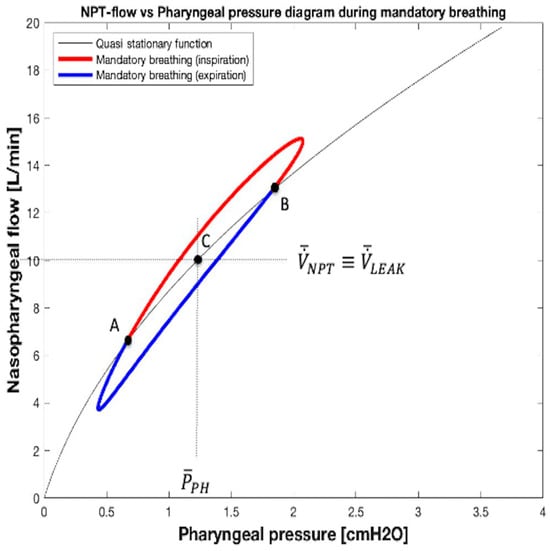
Figure 10.
vs. PPH diagram during mandatory breathing. The continuous line curve in this figure represents Equation (10) (Figure 5b, quasi stationary function). Note that during mandatory breathing, the green segment in Figure 6 is now an ellipsoid. The three solid black dots A, B, and C mark the beginning of inspiration, beginning of expiration, and the equilibrium point set by bias flow (, ), respectively. At both points A and B, is zero.
The hysteresis loop is a representation of the mandatory breath and results, as such, due to the consequence of the capacitive (elastic) component, in the complex impedance that characterizes the (passive) patient’s respiratory system. Over time, the waveform shifts compared to that of PPH. The length of the ellipse-shaped loop’s main axis is contingent on the amount of pumping provided with the balloon (FFPDD), while its slope is influenced by RLEAK and the patient’s respiratory system impedance. The length of the secondary axis of the ellipse-shaped loop, which quantifies the amount of hysteresis, is contingent on the ratio between the resistive and capacitive components that constitute the patient’s respiratory system impedance, as well as non-linear RNPT and RLEAK. During inspiration and expiration, the portion of the loop involved is the one marked in Figure 10 with the red and the blue colors, respectively. As in spontaneous breathing, the oscillation of PPH around occurring during mandatory breathing is normally associated with an oscillation of around bias flow () due to the changing of pressure drop across NPT.
As in spontaneous breathing, from a graphic point of view (Figure 11), the current value of obtained from Equation (10) can be highlighted in the vs. PPH diagram as the value of corresponding to the intersection between the vertical projection passing through the current monitored value of PPH and the − PPH relationship during apnea (Equation (10) shown in Figure 5b, Figure 10 and Figure 11, quasi stationary function). By way of example, Figure 11 shows the minimum () and maximum () values calculated at mid-inspiration and mid-expiration times, respectively. Furthermore, in Figure 11, the values assumed by at mid-inspiration () and mid-expiration () times, respectively, are also highlighted.
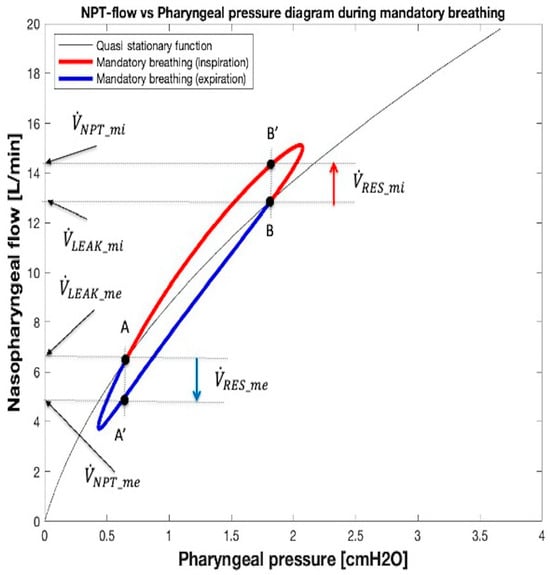
Figure 11.
Graphical method to calculate and at mid-inspiration and mid-expiration times during mandatory breathing. Starting from point B’, associated with mid-inspiration on the red loop, a vertical line is drawn to the x-axis until it intersects the quasi stationary function (Equation (10), Figure 5b) at point B. From point B, a horizontal line is projected on the y-axis. The point of intersection represents at mid-inspiration. is calculated from Equation (1) as the difference between and (red arrow). The blue arrow represents at mid-expiration (point A’ and its projection on the loop, point A).
Finally, during breathing, the current value of associated with the correspondent value of monitored PPH can be computed considering Equation (1), i.e., as the difference between the current monitored value of and the synchronized value of obtained by Equation (10). As an example, the length of the two vertical arrows and reported in Figure 11 correspond to the maximum (positive, red arrow) and minimum (negative, blue arrow) values of occuring at mid-inspiration and at mid-expiration times, respectively. The values of during a whole mandatory breath, calculated in this way, are shown in Figure 12, where each amplitude of red and blue arrows equals the value assumed by inspiratory () and expiratory () flows, respectively.
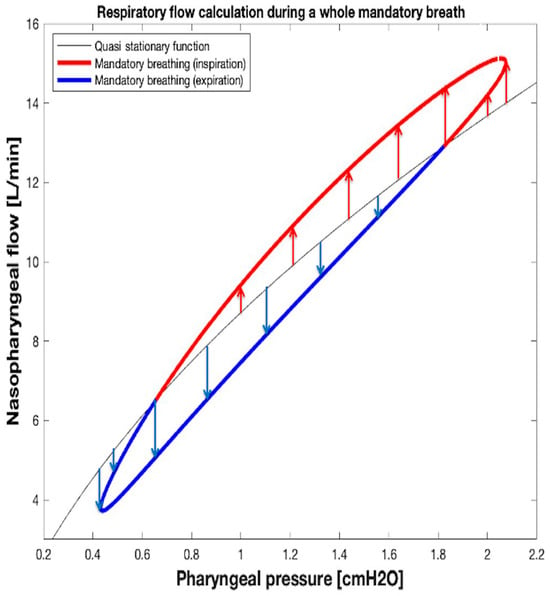
Figure 12.
Graphical method to calculate at any time during mandatory breathing. The length of each red or blue arrow indicates the inspiratory flow () and expiratory flow () value at that point on the loop.
From what has been described so far in this section, it results that the and waveforms over time during mandatory breathing can be computed and monitored real time by inserting into both the Equations (10) and (1) the synchronized samples of the PPH and waveforms over time available from monitoring system. Figure 13 shows the , , and waveforms over time during mandatory breathing (Figure 11 and Figure 12). Finally, tidal volume (VTID) was calculated as the integral over inspiratory time.
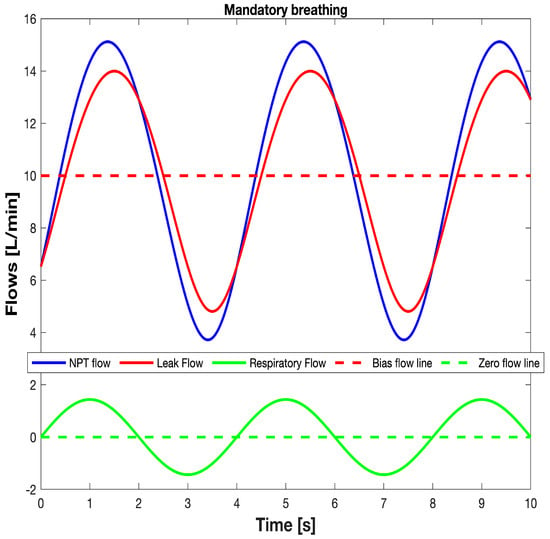
Figure 13.
The typical waveforms over time of (monitored), (monitored), and (calculated) during mandatory breathing.
Again, we assumed that the resistance of the leak channel (RLEAK) remains the same when switching from apnea to mandatory breathing. The approach described in the present section leads to correct results, since, as already highlighted in Section 2.3., the breathing rate is so low (low travel speed along the loop of Figure 10, Figure 11 and Figure 12) that the respiration process can be considered quasi stationary according to the same condition (QSC) for which the preliminary PPH − relationship during apnea was obtained.
2.5. Statistical Analysis
The hypothesis we formulated at the beginning of the test was that the measured VTID (VTID_M) and the calculated VTID (VTID_C) data belong to the same population (null hypothesis). In order to verify the validity of the null hypothesis, we subjected the data obtained for both the variables VTID_M and VTID_C to the paired t Student two-tailed test which is based on the combined estimate of the variance. The critical threshold values of t (t*) associated with the significance level (α) were equal to 0.01 and with the appropriate value of the degrees of freedom (ν) equal to 70 (corresponding to 36 samples for both observed variables: t*0.01 = 2.648). As is known, if the absolute value of t calculated from the data observed is greater than t*0.01, the null hypothesis is to be considered incorrect by accepting that the probability of committing an error is less than or equal to 1%. The test was carried out for all combinations of nominal tidal volume and leak size covering the entire range of clinical interest for NPV applications.
3. Results
In this study, we developed a method to calculate , , and VTID during NPV. Given that NPV operates as an open system, the flow delivered to the patient () must be adjusted by subtracting the flow lost through the mouth (leakage channel, ) to accurately determine the . The procedure for calculating , and thus , consisted of several steps. First, the relationship between PPH and under apneic conditions was characterized. It is noteworthy that this relationship can only be characterized during apnea when the , i.e., the unknown variable, is equal to the flow delivered through the NPT (. The relationship was then interpolated by Rohrer’s equation (Equation (8)) to obtain a curve defined by the coefficients kL_LEAK and kT_LEAK (Figure 5a). Subsequent to this preliminary yet crucial step, the was determined using Equation (10), with the coefficients kL_LEAK and kT_LEAK being those calculated in the initial step. According to Equation (1), the was obtained from the difference between and , and the VTID as the integration of the over the inspiratory time. All the measurement data we obtained were analyzed by the Shapiro–Wilk test, which confirmed that they belong to a normal distribution. Consequently, for any statistical analysis, we considered the following parameters relative to our target variable, i.e., the lung volume inspired by the patient during each breath, (i.e., tidal volume (VTID)): mean (M), standard deviation (SD), and standard error on the mean (SEM).
The accuracy and precision errors associated with the IngMar ASL 5000 Breathing Simulator were assessed as relative error (RE) and coefficient of variation (CV) of VTID. The ER of VTID was calculated in a leak-free system with no background flow and defined by RE (%) = 100 × (M − nominal VTID)/nominal VTID. Nominal VTID (VTID_N) is the value of VTID set for delivering each predetermined value. A percentage of less than 3% was considered acceptable []. The CV of VTID, defined by CV (%) = 100 × (SD/M), was used to describe the reproducibility for VTID. The resulting REs and CVs of VTID were 0.4% and 0.8%, respectively.
The accuracy and precision errors associated with the experimental setup and the acquisition/elaboration software (PicoScope/MATLAB, version R2024b) are reported elsewhere [].
3.1. Results of Coefficient Determination (kL_LEAK and kT_LEAK)
We considered three leak channels with different amounts of flow loss (small, medium, and large leak size) for pediatric and adult applications. The coefficients obtained using the − PPH relationship during apnea, which was analytically interpolated with a second-order polynomial (Equation (8)), are reported in Table 1.

Table 1.
Results of kL_LEAK and kT_LEAK at different leak sizes. The measure of how closely the PPH − relationship matches the fitted equation (Equation (8)) is expressed as GOF.
3.2. Tidal Volume Computing and Validation
To evaluate the accuracy of the algorithm for determining , , and VTID during NPV, we compared the VTID_M measured from detected by the PNT_C (Figure 3) with the VTID_C calculated using the algorithm.
For each selected VTID_N, 36 small leak (SL), 36 medium leak (ML) and 36 large leak (LL) measurements were performed. The data obtained at the end of each measurement consist of the average value of both VTID_M and VTID_C obtained by collecting 1000 consecutive breaths. Normal distribution was tested using the Shapiro–Wilk test. Since the data were normally distributed, for statistical analysis we considered the mean and the standard deviation of both variables studied (VTID_C and VTID_M). Assuming that the type of method used is the only factor affecting the data, the statistical assessment of each comparison at different VTID_N and leak size between VTID_C and VTID_M was performed using the one-way analysis of variance (ANOVA) in the version derived for two groups or variables (paired Student t test).
3.2.1. Validation of Tidal Volume Computation Using the Algorithm for of Spontaneous Breathing
To simulate pediatric applications, with a bias flow and RV setting of 16 L/min and 60 cmH2O/L/s in all cases, we independently varied the amplitude of (A) from 1 to 20 L/min and the duration of the inspiration (TI) from 0.5 to 1 s in order to obtain three target values of VTID_N: 10, 50, and 100 mL delivered through the 3.0, 4.0, and 5.0 mm ID, respectively.
To simulate adult applications, with a bias flow and RV setting of 32 L/min and 60 cmH2O/L/s in all cases, we independently varied A from 10 to 40 L/min and TI from 1 to 2 s in order to obtain three target values of VTID_N: 200, 300, and 400 mL delivered through the 7.0, 8.0, and 9.0 mm ID, respectively.

Table 2.
Statistical data related to tidal volume (VTID) computation for spontaneous breathing.

Table 3.
Results of statistical comparison at different values of VTID_N between VTID_M and VTID_C for spontaneous breathing simulation (paired Student t test).
3.2.2. Validation of Tidal Volume Computation Using the Algorithm for Mandatory Ventilation
In this case, as already mentioned in Section 2.4.4., with the patient’s respiratory system completely passive, the resulting VTID depends on the amplitude of the pumped flow (PF) generated by the anesthetist through their action on the inflated balloon and its time duration (TI), but also on ID size, leak size, patient’s total inspiratory resistance (RP), and compliance (CP). The bias flow and RV should be set to ensure adequate inflating of the balloon in the required time to the desired VTID.
To simulate pediatric applications, with a bias flow and RV setting of 16 L/min and 60 cmH2O/L/s in all cases, we independently varied PF from 1 to 20 L/min and TI from 0.5 to 1 s in order to obtain three target values of VTID_N: 10, 50, and 100 mL delivered through the 3.0, 4.0, and 5.0 mm ID, to a patient with RP = 100 cmH2O/L/s and CP = 10 mL/cmH2O, with RP = 50 cmH2O/L/s and CP = 20 mL/cmH2O and with RP = 20 cmH2O/L/s and CP = 50 mL/cmH2O, respectively.
To simulate adult applications properly, with a bias flow and RV setting of 32 L/min and 60 cmH2O/L/s in all cases, we independently varied PF from 1 to 40 L/min and TI from 1 to 2 s in order to obtain three target values of VTID_N: 200, 300, and 400 mL delivered through the 7.0, 8.0, and 9.0 mm ID, respectively. For all patients, RP and CP were set to 10 cmH2O/L/s and 100 mL/cmH2O, respectively.

Table 4.
Statistical data related to tidal volume (VTID) computation for mandatory breathing.

Table 5.
Results of statistical comparison at different values of VTID_N between VTID_M and VTID_C for mandatory breathing simulation (paired Student t test).
4. Discussion
In response to the clinical demand for a new procedure capable of assessing the real value of the tidal volume inspired by patients while they are assisted with NPV, a new computational method was developed. The purpose of this method is to calculate tidal volume in conditions where direct measurement is otherwise difficult to achieve. Direct measurement of tidal volume necessitates the implementation of a pneumotachograph at the extremity of the leak channel. Given the prevalence of NPV-demanding procedures, such as gastroscopies in small children, the employment of an orofacial mask equipped with a pneumotachograph is impractical, as it would interfere with the actions of physicians.
Any method that aims to monitor the effective value of tidal volume in an open system of ventilation must first determine the waveform during breathing. This objective can be realized if airflow resistance of the leak channel can be accurately evaluated over the entire range of flow values that occur during breathing. The method proposed in this paper includes two steps. The initial step in the procedure is to characterize the relationship between the PPH and , which allows calculation of the coefficients of the interpolated curve according to Rohrer’s equation. As cannot always be measured directly in the patient without a PNT and a mask, it is nevertheless possible to ascertain the relationship between PPH and because there is a period (when the patient is not breathing, i.e., apnea) when . In the second step of the method, an equation is devised that links the , the , the PPH, and the coefficients calculated in the first step during the apnea. This equation is derived during breathing that is either spontaneous or mandatory. After obtaining the waveform, the waveform is calculated as the difference between and . At this point, VTID is obtained from the integration during the inspiratory time of the difference between and .
To the best of our knowledge, our computational method is the first to be developed and tested for tidal volume determination during NPV.
Testing the method’s efficacy involved a comparison between the tidal volume obtained by measurement with a pneumotachograph positioned at tracheal level in the lung simulator (VTID_M), universally regarded as the gold standard, and the tidal volume computed with the algorithm (VTID_C).
The criteria chosen to properly evaluate the reliability of the results obtained with the algorithm (VTID_C) compared to those obtained with the gold standard (VTID_M) for different values of nominal tidal volume (VTID_N) and leak size typical for pediatric and adult applications, both for spontaneous and mandatory breaths, showed a similar magnitude of error. Specifically, the reported data show that in no case does the absolute value of t exceed t*0.01, indicating that there is no statistically significant difference between VTID_C and VTID_M in any of the cases studied. From this result, it follows that the null hypothesis can be accepted, confirming the validity of the algorithm presented here compared to the gold standard. In other words, the reliability of the results obtained with the algorithm is comparable to that obtained with the gold standard (i.e., with a pneumotachograph placed downstream of the leak).
4.1. Other Methods to Measure Tidal Volume During Nasal Ventilation
In the neonatal population, intermittent positive pressure ventilation administered via nasal mask or prongs, short or long, single or bi-nasal, is a prevalent clinical practice. The necessity of monitoring tidal volume in infants with acute respiratory failure or in those with healthy lungs during procedural sedation arises due to its correlation with clinical outcomes. The quantification of tidal volume in patients under NPV poses a significant challenge. Numerous clinical studies have examined direct or indirect methods, but the results have been disappointing. For example, Matlock et al. measured tidal volume transmission during non-synchronized nasal intermittent positive pressure ventilation by respiratory inductance plethysmography in a group of preterm infants []. With this method, mean tidal volumes were expressed in arbitrary units, which makes comparisons with other studies impossible. In a recent study in adult patients, Janssen and colleagues endeavored to ascertain the validity of ultrasound measurements of diaphragm excursion as a surrogate marker for tidal volume in patients with respiratory failure. However, a notable disparity emerged between the observed and predicted tidal volumes. Furthermore, substantial variability was observed in tidal volume estimation among study participants. Consequently, the reliability of quantifying absolute tidal volume from diaphragm excursion remains questionable []. Lenhardt et al. tested the hypothesis that nasopharyngeal ventilation is superior in its efficacy compared to traditional facemask ventilation. The primary outcome was tidal volume. In this case, tidal volume was measured with a pneumotachograph via a method aiming to minimize the (simultaneous sealing of the mouth and nares) which could be unfeasible in other contexts []. More sophisticated studies come from the group of Schmalisch and colleagues, who compared data obtained using different leak modeling and in vitro measurements []. Fischer et al. investigated tidal volume and leak measurements during CPAP in neonates using a commercial ventilatory device equipped with a flow sensor at the Y-piece. During nasopharyngeal CPAP, leak and tidal volumes were measured using the commercial ventilator and an algorithm to correct measured tidal volume in the presence of leaks. Leak and corrected tidal volume could be determined in the presence of leaks of up to 69%, but leaks during CPAP often exceeded the measuring range. The authors therefore concluded that advanced equipment was necessary to further investigate the effects of leaks on neonatal CPAP therapy [].
4.2. Clinical Implications
The experimental results of the present study provide a basis for conducting clinical trials to determine the validity of the proposed method in patient populations supported by NPV. In the context of upper gastrointestinal endoscopy, the implementation of the mask with the pneumotachograph has the potential to interfere with the movements of the endoscopist. This in turn adds another layer of complexity to the procedure.
4.3. Limitations
The method is based on the premise that the airflow resistance of the leak channel during both spontaneous and mandatory breathing is nearly the same as that calculated in the apnea condition. It also assumes that the patient’s respiratory mechanics are linear during mandatory ventilation. The validity of these assumptions may not always be guaranteed in vivo. In this study, a healthy lung model was utilized, as the primary application of NPV is in procedural sedation. Further studies are currently being conducted to investigate potential differences in cases involving diseased lungs.
5. Conclusions
The findings documented in this study demonstrate the validity and potential usefulness of the algorithm devised for the real-time detection of leak flow (), respiratory flow (), and tidal volume (VTID) waveforms during NPV. This algorithm has the potential to provide anesthetists with a valuable instrument to optimize the control of both zaspontaneous and mandatory breathing during nasopharyngeal ventilation through accurate tidal volume estimation in patients. Further studies will be conducted to verify the in vivo feasibility of this method.
Author Contributions
Conceptualization, F.M. and P.P.; methodology, F.M. and P.P.; software, F.M.; validation, F.M. and P.P.; formal analysis, F.M. and P.P.; investigation, F.M. and P.P.; resources, F.M. and P.P.; data curation, F.M. and P.P.; writing—original draft preparation, F.M. and P.P.; writing—review and editing, F.M. and P.P.; visualization, F.M. and P.P.; supervision, F.M. and P.P. All authors have read and agreed to the published version of the manuscript.
Funding
This research received no external funding.
Institutional Review Board Statement
Not applicable.
Informed Consent Statement
Not applicable.
Data Availability Statement
Data are contained within the article. Further data that support the findings of this study are available upon request from the corresponding author.
Conflicts of Interest
The authors declare no conflicts of interest.
References
- Mehta, S.; Hill, N.S. Noninvasive ventilation. Am. J. Respir. Crit. Care Med. 2001, 163, 540–577. [Google Scholar] [CrossRef] [PubMed]
- Criner, G.J.; Gayen, S.; Zantah, M.; Castillo, E.D.; Naranjo, M.; Lashari, B.; Pourshahid, S.; Gangemi, A. Clinical review of non-invasive ventilation. Eur. Respir. J. 2024, 64, 2400396. [Google Scholar] [CrossRef] [PubMed]
- Lenhardt, R.; Akca, O.; Obal, D.; Businger, J.; Cooke, E. Nasopharyngeal ventilation compared to facemask ventilation: A prospective, randomized, crossover trial in two different elective cohorts. Cureus 2023, 15, e39049. [Google Scholar] [CrossRef] [PubMed]
- Papoff, P.; Rosini, T.; Oliva, S.; Luciani, S.; Midulla, F.; Montecchia, F. Nasopharyngeal tubes in pediatric anesthesia: Is the flow-dependent pressure drop across the tube suitable for calculating oropharyngeal pressure ? Pediatr. Anaesth. 2021, 31, 809–819. [Google Scholar] [CrossRef]
- Kondo, T.; Matsumoto, I.; Lanteri, C.J.; Sly, P.D. Respiratory mechanics during mechanical ventilation: A model study on the effect of leak around a tracheal tube. Pediatr. Pulmonol. 1997, 24, 423–428. [Google Scholar] [PubMed]
- Mohmoud, R.A.; Fischer, H.S.; Proquittè, H.; Abudaif Shalaby, H.M.; Schmalish, G. Relationship between endotracheal tube leakage and under-reading of tidal volume in neonatal ventilators. Acta Pediatr. 2009, 98, 1116–1122. [Google Scholar] [CrossRef] [PubMed]
- Brochard, L. Mechanical ventilation: Invasive versus noninvasive. Eur. Respir. J. 2003, 22 (Suppl. S47), 31s–37s. [Google Scholar] [CrossRef] [PubMed]
- Rabec, C.; Georges, M.; Kabeya, N.K.; Baudouin, N.; Massin, F.; Reybet-Degat, O.; Camus, P. Evaluating noninvasive ventilation using a monitoring system coupled to a ventilator: A bench-to-bedside study. Eur. Respir. J. 2009, 34, 902–913. [Google Scholar] [CrossRef] [PubMed]
- Fischer, H.S.; Roehr, C.C.; Proquitté, H.; Hammer, H.; Wauer, R.R.; Schmalisch, G. Is volume and leak monitoring feasible during nasopharyngeal continuous positive airway pressure in neonates? Intensive Care Med. 2009, 35, 1934–1941. [Google Scholar] [CrossRef] [PubMed]
- Storre, J.H.; Bhom, P.; Dreher, M.; Windisch, W. Clinical impact of leak compensation during non-invasive ventilation. Respir. Med. 2009, 103, 1477–1483. [Google Scholar] [CrossRef] [PubMed][Green Version]
- Montecchia, F.; Midulla, F.; Papoff, P. A flow-leak correction algorithm for pneumotachographic work-of-breathing measurements during high-flow nasal cannula oxygen therapy. Med. Eng. Phys. 2018, 54, 32–43. [Google Scholar] [CrossRef] [PubMed]
- Schmalisch, G.; Fischer, H.; Roehr, C.C.; Proquittè, H. Comparison of different techniques to measure air leak during CPAP treatment in neonates. Med. Eng. Phys. 2009, 31, 124–130. [Google Scholar] [CrossRef] [PubMed]
- Vicario, F.; Alkhairy, S.; Buizza, R.; Truschel, W.A. Two-parameters leak estimation in non-invasive ventilation. In Proceedings of the 39th Annual International Conference of IEEE Engineering in Medicine and Biology Society (EMBS), Jeju, Republic of Korea, 11–15 July 2017; pp. 153–156. [Google Scholar] [CrossRef]
- Quiao, H.; Liu, T.; Yin, J.; Zhang, Q.I. The detection and estimation of the air leakage in noninvasive ventilation: Platform study. J. Mech. Med. Biol. 2020, 20, 2040043. [Google Scholar] [CrossRef]
- Foitzik, B.; Schmidt, M.; Windstetter, D.; Wauer, R.R.; Schmalish, G. Leak measurements in spontaneously breathing premature newborns by using the flow-through technique. J. App. Physiol. 1998, 85, 1187–1193. [Google Scholar] [CrossRef] [PubMed][Green Version]
- Oto, J.; Chenelle, C.T.; Marchese, A.D.; Kacmarek, R.M. Acomparison of leak compensation during pediatric noninvasive ventilation: A lung model study. Respir. Care 2014, 59, 241–251. [Google Scholar] [CrossRef] [PubMed]
- Banner, M.J.; Tams, C.G.; Euliano, N.R.; Stephan, P.J.; Leavitt, T.J.; Martin, A.D.; Al-Rawas, N.; Gabrielli, A. Real time noninvasive estimation of work of breathing using facemask leak-corrected tidal volume during noninvasive pressure support: Validation study. J. Clin. Monit. Comput. 2016, 30, 285–294. [Google Scholar] [CrossRef]
- Montecchia, F.; Papoff, P. Real-Time Optimal Flow Setting and Respiratory Profile Evaluation in Infants Treated with High-Flow Nasal Cannula (HFNC). Fluids 2024, 9, 93. [Google Scholar] [CrossRef]
- Rohrer, F. Flow resistance in human air passages and the effect of irregular branching of the bronchial system on the respiratory process in various regions of the lungs. Arch. Ges. Physiol. 1915, 162, 225–299. [Google Scholar] [CrossRef]
- Matlock, D.N.; Bai, S.; Weisner, M.D.; Comtois, N.; Beck, J.; Sinderby, C.; Courtney, S.E. Tidal volume transmission during non-synchronized nasal intermittent positive pressure ventilation via RAM cannula. J. Perinatol. 2019, 39, 723–729. [Google Scholar] [PubMed]
- Janssen, M.L.; Jonkman, A.H.; Wennen, M.; Wils, E.-J.; Endeman, H.; Heunks, L. Diaphragm excursions as proxy for tidal volume during spontaneous breathing in invasively ventilated ICU patients. Intensive Care Med. Exp. 2023, 11, 73. [Google Scholar] [CrossRef] [PubMed]
Disclaimer/Publisher’s Note: The statements, opinions and data contained in all publications are solely those of the individual author(s) and contributor(s) and not of MDPI and/or the editor(s). MDPI and/or the editor(s) disclaim responsibility for any injury to people or property resulting from any ideas, methods, instructions or products referred to in the content. |
© 2025 by the authors. Licensee MDPI, Basel, Switzerland. This article is an open access article distributed under the terms and conditions of the Creative Commons Attribution (CC BY) license (https://creativecommons.org/licenses/by/4.0/).